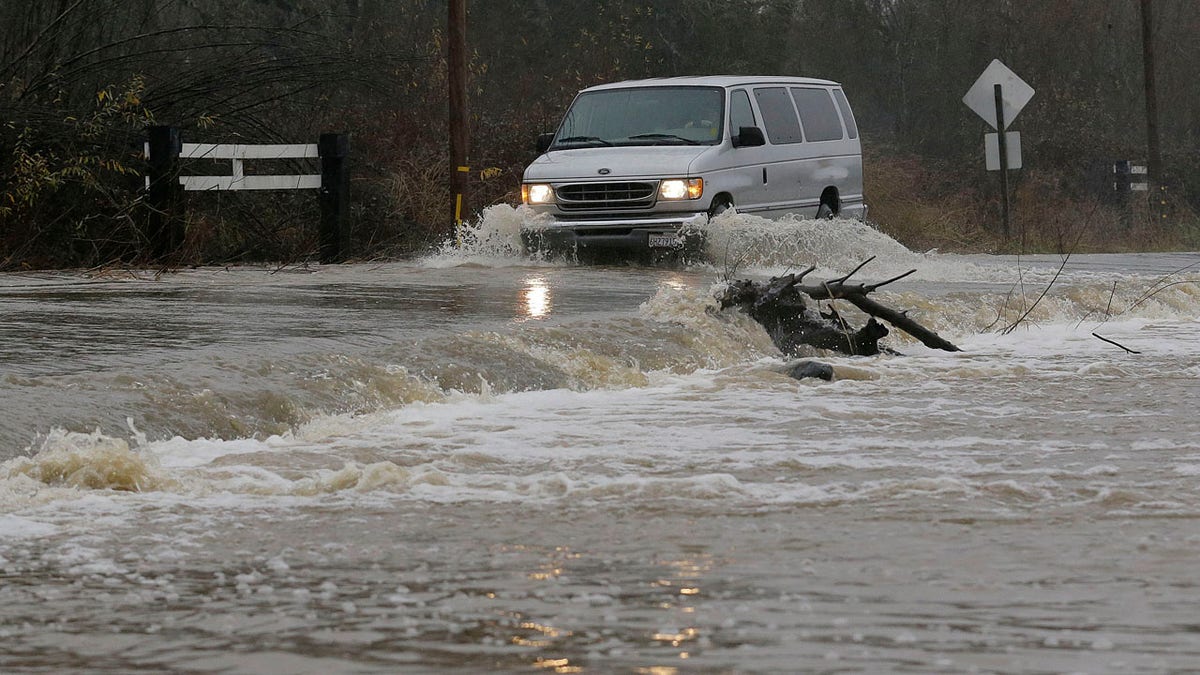
Jan. 7, 2017: A van drives through flooded water on Green Valley Road in Graton, Calif. (AP Photo/Jeff Chiu)
Rivers were rising and winds were whipping up across Northern California on Sunday as a massive storm that could be the biggest to slam the region in more than a decade arrived.
Residents and authorities cleared storm drains and stacked sand bags, preparing for the system expected to reach full force late Sunday and early Monday.
Some flooding was reported Sunday morning, including along U.S. 101 in Sonoma County, where stranded motorists had to be rescued. Swift water teams performed rescues at a mobile home park in Marin County, where officials reported road closures and some damage from flooding and fallen trees.
Authorities were watching rising water levels of several rivers, including the Cosumnes, Truckee, Merced, American and Russian.
Forecasters warned of heavy rain that could down trees and trigger mudslides as the system gains strength throughout the day. Several feet of snow were predicted in the Sierra Nevada. A woman was killed Saturday by a falling tree on the San Francisco Bay Area golf course.
The stormy weather comes as California enters its sixth year of drought. Each drop of rain is welcomed, but officials said several more big storms are needed to replenish depleted groundwater supplies.
The strong wet season began in October with more rain falling than in three decades, mostly in Northern California. Los Angeles, which will likely get the brunt of the latest system early Monday, is experiencing its wettest winter in six years, forecasters said.
Forecasters anticipate the storm surge stretching from Hawaii — called an atmospheric river — could dump up to 15 inches of rain in some foothills communities.
The storm's relatively mild temperatures will drive up the snowline to above 9,000 feet throughout the Sierra Nevada, causing runoff in the lower elevations, said Zach Tolby, a meteorologist with the National Weather Service in Reno, Nevada.
Flooding could rival the winter of 2005-06 that sent 5 feet of water into an industrial area in Sparks, Nevada. Crews worked to secure storage drums filled with hazardous materials to stop them from floating away as they have in past floods.
In the Pacific Northwest, residents braced for treacherous roads and the possibility of nuisance flooding. Most flights were canceled at the airports in Portland and Eugene, Oregon. Officials urged residents in Boise, Idaho to dig pathways to allow rain and runoff from 15 inches of snowmelt to drain.
Back in California Rangers at Yosemite National Park closed all roads leading to the park's valley floor, a major attraction for visitors from around the world eager to view gushing waterfalls and gaze up at towering granite rock formations such as El Capitan and Half Dome. Other parts of the park remain open, but rangers cautioned visitors to be aware of ice and falling debris on the roads.
Photographer and rock climber Josh Hilling, who lives in the foothills below the park, spent recent days chopping wood and stocking up on groceries.
"If you live long enough in this canyon, you experience lots of natural disasters — floods, fires, rock falls," Hilling said Friday from his family's home in El Portal.
Another storm is forecast for Tuesday and with the ground already saturated, rain won't seep into the soil quickly enough and extra runoff could end up in already swollen rivers and creeks, officials said.

